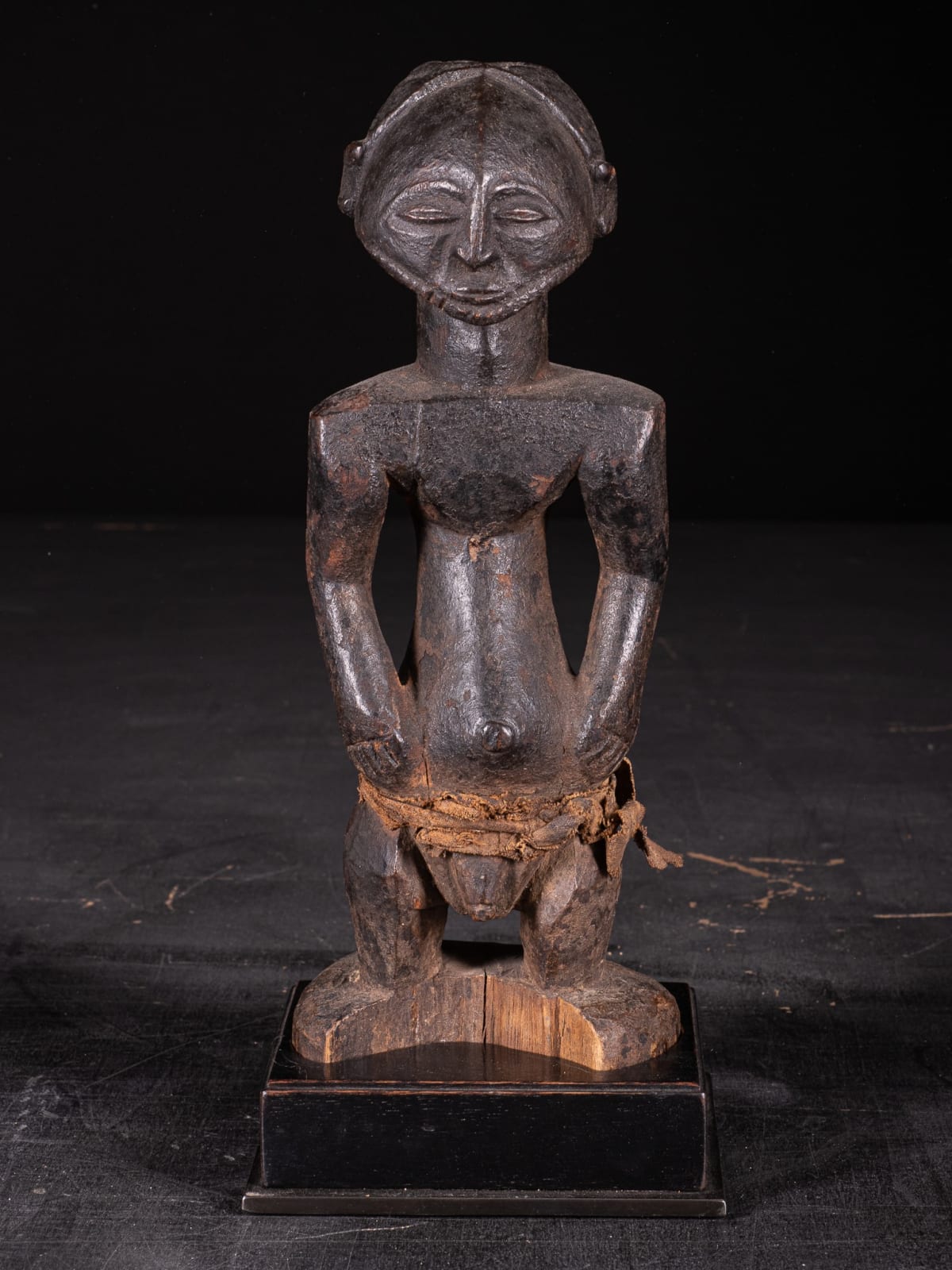Hemba Commemorative Ancestor '"singit" Statue of a Chief, DRC
1st half 20th Century
Wood
36 x 11 x 15 cm
2007
€ 9,900.00
Further images
The Hemba people are a Bantu ethnic group in the Democratic Republic of the Congo (DRC). In the 1800s, under the direction of Niembo and his son, Myhiya, the Hemba moved into their current location along the Congo River. The Luba unsuccessfully tried to incorporate them into their growing kingdom. However, the Luba did succeed in greatly influencing their artistic styles in ancestral figures, spirits, human faces, and ceremonial masks. The art of the Hemba is mainly known for the ancestor's figures, the Singita, symbols of power who exude wonderful serenity and natural authority. These statues were not only to keep the memory of their great chiefs alive but also to justify the present authority and power of the clan chief; the latter had absolute jurisdiction over clan members and was in charge of several ancestor figures he kept in his funerary hut. Singiti were used in all Hemba ceremonies and court decisions. Although every figure is the portrait of a specific person, the artist portrays generalized, not particular, individual traits. The figure expresses equilibrium, symmetry and refinement. The sculptural beauty reveals the highest moral qualities. The serenely closed eyes and the rounded face reflects the ancestor's interior calm. The typical lobed hairdo evokes the four directions of the universe and the crossroad where spirits assemble. Hands-on, each side of the swelling belly indicate the ancestor embracing and watching over descendants. The statue has a charming use and wears a patina.
Les Hemba sont un groupe ethnique bantou en République démocratique du Congo (RDC). Au XIXe siècle, sous la direction de Niembo et de son fils, Myhiya, les Hemba se sont installés le long du fleuve Congo, à leur emplacement actuel. Les Luba ont tenté en vain de les incorporer à leur royaume en expansion. Cependant, les Luba ont réussi à influencer grandement leurs styles artistiques dans les figures ancestrales, les esprits, les visages humains et les masques cérémoniels. L'art des Hemba est principalement connu pour les figures d'ancêtres, les Singita, symboles de pouvoir qui dégagent une merveilleuse sérénité et une autorité naturelle. Ces statues servaient non seulement à conserver la mémoire de leurs grands chefs, mais aussi à justifier l'autorité et le pouvoir actuels du chef de clan ; ce dernier avait une juridiction absolue sur les membres du clan et était responsable de plusieurs figures d'ancêtres qu'il conservait dans sa hutte funéraire. Les Singiti étaient utilisés lors de toutes les cérémonies et décisions de justice des Hemba. Bien que chaque figure soit le portrait d'une personne spécifique, l'artiste représente des traits individuels généralisés, et non particuliers. La figure exprime l'équilibre, la symétrie et le raffinement. La beauté sculpturale révèle les plus hautes qualités morales. Les yeux sereinement clos et le visage arrondi reflètent le calme intérieur de l'ancêtre. La coiffure lobée typique évoque les quatre directions de l'univers et le carrefour où les esprits se rassemblent. Les mains posées de chaque côté du ventre rebondi indiquent que l'ancêtre embrasse et veille sur ses descendants.
Les Hemba sont un groupe ethnique bantou en République démocratique du Congo (RDC). Au XIXe siècle, sous la direction de Niembo et de son fils, Myhiya, les Hemba se sont installés le long du fleuve Congo, à leur emplacement actuel. Les Luba ont tenté en vain de les incorporer à leur royaume en expansion. Cependant, les Luba ont réussi à influencer grandement leurs styles artistiques dans les figures ancestrales, les esprits, les visages humains et les masques cérémoniels. L'art des Hemba est principalement connu pour les figures d'ancêtres, les Singita, symboles de pouvoir qui dégagent une merveilleuse sérénité et une autorité naturelle. Ces statues servaient non seulement à conserver la mémoire de leurs grands chefs, mais aussi à justifier l'autorité et le pouvoir actuels du chef de clan ; ce dernier avait une juridiction absolue sur les membres du clan et était responsable de plusieurs figures d'ancêtres qu'il conservait dans sa hutte funéraire. Les Singiti étaient utilisés lors de toutes les cérémonies et décisions de justice des Hemba. Bien que chaque figure soit le portrait d'une personne spécifique, l'artiste représente des traits individuels généralisés, et non particuliers. La figure exprime l'équilibre, la symétrie et le raffinement. La beauté sculpturale révèle les plus hautes qualités morales. Les yeux sereinement clos et le visage arrondi reflètent le calme intérieur de l'ancêtre. La coiffure lobée typique évoque les quatre directions de l'univers et le carrefour où les esprits se rassemblent. Les mains posées de chaque côté du ventre rebondi indiquent que l'ancêtre embrasse et veille sur ses descendants.
Provenance
Belgian Private CollectionJoin our mailing list
* denotes required fields
We will process the personal data you have supplied in accordance with our privacy policy (available on request). You can unsubscribe or change your preferences at any time by clicking the link in our emails.











